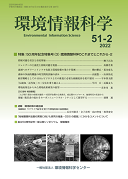Volume 51, Issue 2
Environmental Information Science, Vol.51, No.2
Displaying 1-20 of 20 articles from this issue
- |<
- <
- 1
- >
- >|
Cover
-
Article type: Cover
2022 Volume 51 Issue 2 Pages cover-
Published: July 21, 2022
Released on J-STAGE: January 21, 2023
Download PDF (1712K)
Contents
-
Article type: Contents
2022 Volume 51 Issue 2 Pages 0-
Published: July 21, 2022
Released on J-STAGE: January 21, 2023
Download PDF (590K)
Special Issue: Historical Transitions and Future Prospects of Environmental Information Science-2
-
Article type: Special Feature Papers
2022 Volume 51 Issue 2 Pages 1-6
Published: July 21, 2022
Released on J-STAGE: January 21, 2023
Download PDF (1371K) -
Article type: Special Feature Papers
2022 Volume 51 Issue 2 Pages 7-13
Published: July 21, 2022
Released on J-STAGE: January 21, 2023
Download PDF (959K) -
Article type: Special Feature Papers
2022 Volume 51 Issue 2 Pages 14-20
Published: July 21, 2022
Released on J-STAGE: January 21, 2023
Download PDF (1130K) -
Article type: Special Feature Papers
2022 Volume 51 Issue 2 Pages 21-25
Published: July 21, 2022
Released on J-STAGE: January 21, 2023
Download PDF (954K) -
Article type: Special Feature Papers
2022 Volume 51 Issue 2 Pages 26-31
Published: July 21, 2022
Released on J-STAGE: January 21, 2023
Download PDF (888K) -
Article type: Special Feature Papers
2022 Volume 51 Issue 2 Pages 32-36
Published: July 21, 2022
Released on J-STAGE: January 21, 2023
Download PDF (1120K) -
Article type: Special Feature Papers
2022 Volume 51 Issue 2 Pages 37-41
Published: July 21, 2022
Released on J-STAGE: January 21, 2023
Download PDF (821K) -
Article type: Serial contribution for 50th anniversary
2022 Volume 51 Issue 2 Pages 42-50
Published: July 21, 2022
Released on J-STAGE: January 21, 2023
Download PDF (990K) -
Article type: editional note
2022 Volume 51 Issue 2 Pages 51-53
Published: July 21, 2022
Released on J-STAGE: January 21, 2023
Download PDF (768K)
Series: Frontier of Environmental Policies
-
Article type: round-table discussion
2022 Volume 51 Issue 2 Pages 54-62
Published: July 21, 2022
Released on J-STAGE: January 21, 2023
Download PDF (1295K)
Comments on CEIS's Proposal for Promotion of research for the realization of " Regional Circular and Ecological Sphere "
-
Article type: other
2022 Volume 51 Issue 2 Pages 63-73
Published: July 21, 2022
Released on J-STAGE: January 21, 2023
Download PDF (1267K)
2021 CEIS Symposium Reports
-
Article type: meeting-report
2022 Volume 51 Issue 2 Pages 74-84
Published: July 21, 2022
Released on J-STAGE: January 21, 2023
Download PDF (2298K)
2021 CEIS Planning Sessions Reports
-
Article type: 2021 CEIS Planning Sessions Reports
2022 Volume 51 Issue 2 Pages 85-86
Published: July 21, 2022
Released on J-STAGE: January 21, 2023
Download PDF (867K) -
Article type: 2021 CEIS Planning Sessions Reports
2022 Volume 51 Issue 2 Pages 87-88
Published: July 21, 2022
Released on J-STAGE: January 21, 2023
Download PDF (896K) -
Article type: 2021 CEIS Planning Sessions Reports
2022 Volume 51 Issue 2 Pages 89-90
Published: July 21, 2022
Released on J-STAGE: January 21, 2023
Download PDF (908K)
Research Paper
-
Article type: research-article
2022 Volume 51 Issue 2 Pages 91-97
Published: July 21, 2022
Released on J-STAGE: January 21, 2023
Download PDF (6102K) -
Article type: research-article
2022 Volume 51 Issue 2 Pages 98-107
Published: July 21, 2022
Released on J-STAGE: January 21, 2023
Download PDF (2523K)
Colophon
-
Article type: Colophon
2022 Volume 51 Issue 2 Pages 114
Published: July 21, 2022
Released on J-STAGE: January 21, 2023
Download PDF (542K)
- |<
- <
- 1
- >
- >|
